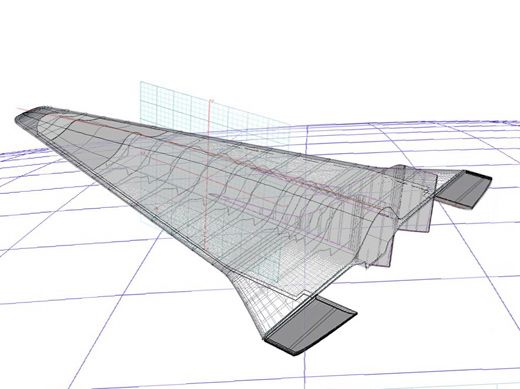Picturing the Future
How a skilled artist fast-forwards to the hypersonic airplanes of 2025.
/https://tf-cmsv2-smithsonianmag-media.s3.amazonaws.com/filer/falcon-wireframe-388-sept07.jpg)
To illustrate our September 2007 feature on the future of hypersonic flight (“Mach 20 or Bust”), artist Paul DiMare had to envision vehicles that won’t exist for another decade or more. We asked him to create animations showing the process of creating the images . Then we asked him to describe the steps. Not surprisingly, it begins with research:
First I gather as much reference material from as many sources as possible. Then I start the painstaking process of building up an accurate wireframe skeleton of all the elements that will make up the final image. For an aircraft, this typically involves drawing precise cross-sections that can be “skinned,” using a process called NURBs—a model used by computer graphics programs to render curved surfaces. This wireframe skeleton is then converted into a solid, with openings left for attaching additional structures (flaps, wings, rudders, etc.)
Next I assign surface properties, called shaders, to our 3-D model. This determines the color, reflectivity, transparency, surface roughness, amount of weathering, etc. I apply many layers (up to 20 shaders) to achieve the desired look. These include many 2-D custom texture maps to create specular (lighting) effects, weathering, logos, and other features.
My next step is to build up the background using the same techniques I used to create the airplane model. For land we create complex 3-D mesh surfaces that can be deformed with special shaders to create elevations. Then I create and layer color (2-D artwork) maps, along with bump shaders that are applied to my 3-D surface to define rivers, mountains and deserts. Next I layer in clouds and haze for atmosphere.
Now comes the fun part that every kid who has ever played with a toy would relate to—I position and light my 3-D elements into a composition pleasing to me and my editors (this can take a long time to arrive at a consensus). Then, after several render tests to get things looking just right, I have my computers render out the final image. This final version needs to be color-corrected and touched up in an image editing program, then cropped to fit the exact size for high-resolution printing.
To create these images I used the following:
Software: form•Z (3-D), Photoshop (2-D)
Hardware: Mac dual-core G5 and G4s
Peopleware: Extreme patience from my editors, and lots of coffee.
